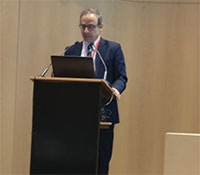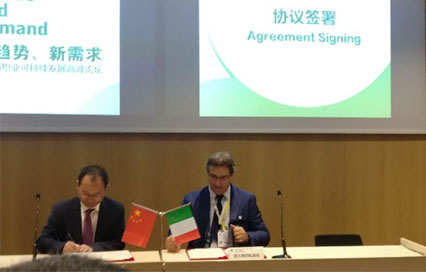"On the first day at ITMA 2019, China Textile Magazine organized the Tex Summit Global-a conference on the sustainable trends and demand in the textile industry with a focus on Chinese textile industry and Shaoxing district where largest concentration of textile manufacturing and dyeing finishing units is centered in China"
 On the first day at ITMA 2019, China Textile Magazine organized the Tex Summit Global-a conference on the sustainable trends and demand in the textile industry with a focus on Chinese textile industry and Shaoxing district where largest concentration of textile manufacturing and dyeing finishing units is centered in China
On the first day at ITMA 2019, China Textile Magazine organized the Tex Summit Global-a conference on the sustainable trends and demand in the textile industry with a focus on Chinese textile industry and Shaoxing district where largest concentration of textile manufacturing and dyeing finishing units is centered in China
In his welcoming address, GaoYong, Party Secretary & SG-General of China National Textile & Apparel Council, said, “Shaoxing is one of the greatest hub for textiles in China, especially for dyeing and printing. China wasgrowing at the rate was 3 percent, while in 2019, it is growing at only 2.9 percent. So far, the apparel sector has reported negative growth, while the export growth rate is 8 percent. The domestic demand is mainly coming from online sales, which is growing by 22 percent, representingone third of entire sales, against 8 percent growth.
Party added, “Majority of the growth is coming from polyester and manmade fibres, which has a global share of 70 percent, while China has80 percent.” According to the study, China houses over 150 million people in its towns and cities who earn as much as people in developed countries.
70 percent, while China has80 percent.” According to the study, China houses over 150 million people in its towns and cities who earn as much as people in developed countries.
Expressing his concern over the current political situation in China, Party avered, “Since April 2019, the whole environment has become more complex. Trade war has cost a new downsize in textile and apparel, especially last few months, as business is decreasing. Exports to the USA and the rest of the world have been largely impacted. If war actually happens, the situation will worsen further. Pricesof finished goods have declined, but price of fabrics and raw material have increased. This has made the whole situation complicated.
According to Party, the three main features and trends currently being observed in China include: A growing interest in building factories in foreign countries like South Asia, Bangladesh, Vietnam, Cambodia, etc; development of technology from online retail front and green sustainability. “We are now accelerating adjustments that require new investment, high technology etc.,” he added.
Dr Christian Schindler, DG, ITMF made an interesting presentation on “The outlook for the development of the global textile industry and interpretation of global textile machinery trade data” at the summit. He presented various trade statistics that indicatedthe countries that are growing across the world. “Changing consumption patterns, growth in online retail, decrease in energy consumption and recycling, etc as the main drivers of this change,” he noted.
“However, continuing political tensions in Turkey, elections in India and trade war in China have impactedthe buyer sentiments,” Schindler added. Suggesting, what to expect from future, he noted, “Investing in high technology, increasing productivity and depending less on human resource to balance the labor cost increase, increasing consumption of polyester fibre and polyester filament will reduce water consumption, chemical process, energy consumption, driving the industry to next level.
He also indicated based on the statistics, design development and manufacturing with new bio based fibres, digital printing, product development based on integration of supply chain and intelligent manufacturing with reducing cost, better automation, productivity, flexibility and quick market response are the trends that are being foreseen.












